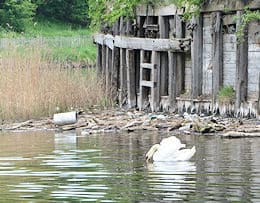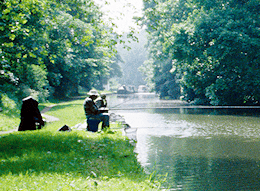Canals have helped preserve much of our natural environment
Not just the canal architecture and engineering is over two hundred years old. The natural environment is also often much as it was then, and had been for centuries before.
Canal towpaths, embankments and cuttings have not been cultivated and covered in chemicals like the rest of our countryside. Old hedgerows, frequently uprooted to make larger more profitable fields, still line the canals. Wild flowers no longer common in intensively farmed meadows, still grow in profusion along canal and river banks.
The canals form linear parkways, extending across wide varieties of landscape, from watermeadows to moorland, through peat, chalk, gravel and granite, and so play host to an enormous range of flora and fauna, often reaching right into city centres.
And although the water in canals may sometimes look muddy it is actually usually fairly unpolluted. Unlike rivers, canals do not carry industrial waste or drainage away from cities. Canals have their own reservoirs, although it must be admitted that they sometimes take the purified waste water from sewage treatment plants, this water has to comply with strict cleanliness standards. Hence the canals support large numbers of birds which feed off fish or other water creatures or plants.
You can see swans, ducks, moorhens, coots, herons and possibly the blue flash of a kingfisher as it skims the canal ahead of you.
Canal towpaths and surrounding areas support a large variety of wildlife, some easier to see than others. Summer days bring out butterflies and dragonflies, evenings you may hear frogs and toads croaking in the rushes, foxes barking or badgers howling in the woods. You may see bats flitting through the dark, many living in old buildings near canals and some in tunnels such as Barnton and Saltersford Tunnels on the Trent and Mersey Canal which have their own resident populations. (The rare pipistrelle bat in this case.)
Watervoles can be seen swimming across the canal, although the voracious mink has taken a heavy toll on their numbers. Grey squirrels are common in most woods, red squirrels less so these days. You may even be lucky enough to see a stoat or weasel out hunting.
Fishing is said to be the most popular leisure activity in Britain, a statistic you can understand when you cruise though a fishing competition where the anglers go on for miles! Most stretches of canal have fishing rights owned by an angling association. Some will sell day permits. The canal is often specially stocked with fish by the association so they are keen that only their members benefit.
As well as the good sport, the canals provide pleasant and tranquil surroundings, a pleasant escape for many town and city dwellers. Common fish include roach. bream, carp, chub, perch and pike. Most anglers have their own favourite spots to fish, avoid places like bridges or locks where boats will get in your way and you will get in theirs.
All materials and images © Canal Junction Ltd. Dalton House, 35 Chester St, Wrexham LL13 8AH. No unauthorised reproduction.
About | Terms | Privacy| Refunds & Returns| Sitemap | Contact Us
With over 800 pages, this website uses cookies to record visitor behaviour using Google Analytics. More information on Privacy Page. Page last updated: 31/03/2025.




Back to Menu....
Canal Heritage >>
Heritage Matters >>